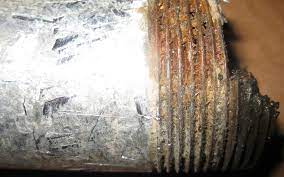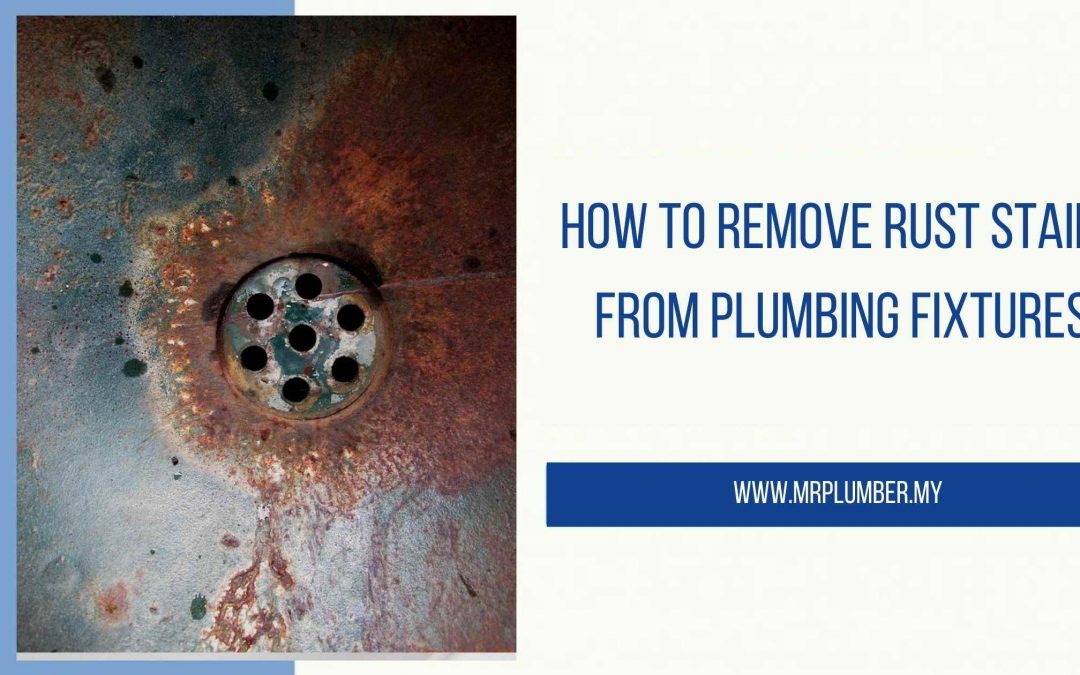Have you ever dealt with a plumbing fixture tarnished with rust stains?
It can be frustrating to see your beautiful fixtures marred by ugly stains.
Luckily, it’s easy to remove them! Here are some tips by Mr.Plumber on how to get rid of those pesky rust stains from your plumbing fixtures.
Table of Contents
What causes rust in your plumbing system?

Before we can remove the rust, we need to know how it got there
There are a few different sources for rust in your plumbing system:
1. Internal pipe corrosion – This happens when water flow rates are too low or the calcium and magnesium content of water is high. You will see this as brown stains on fixtures, drains, flooring and even walls.
2. External stain from surface water (from roof) – This is usually a green or black stain. It gets worse in elevated temperatures and appears inside walls and floors as well as on fixtures.
3. External staining from ground water (typically red or orange) – These stains appear in the same places as surface water stains, depending on the minerals present in your soil.
4. Internal corrosion from a leaking pipe joint – Usually seen as light brown stains in the same places as internal pipe corrosion, but also showing up on fixtures and toilet tanks. It may look like slightly smeared dirt.
5. Internal pipe corrosion from galvanized iron plumbing pipes (very rare) – This will usually be faint orange or rust-colored spots on sinks, tubs and other fixtures.
6. Internal pipe corrosion from copper plumbing pipes (rare to rare) – You would see a very slight greenish-brown color.
What are the dangers of a rust stain and how to prevent them?
Rust is not dangerous, but it can be unsightly. If left untreated, it will continue to bleed through paint or plaster and over time may cause damage to your home’s structure by eating through wood or metal studs. It can also harbor bacteria and mold.
How to remove rust stains from plumbing fixtures?
You should start with the least invasive method and work your way up. Depending on the severity of your stain, you may have to do multiple steps. For example, if you have surface water or ground water staining coming from your roof, one treatment method will not work — it is a combination of several treatments that will work best.
1. Have the water analyzed – If you have an algae bloom, it may be caused by your water’s high phosphate content, which means iron in your plumbing system is leaching into your home’s drinking water. You will need to contact your city’s water department to have a professional analysis done.
2. Paint over it – This is the fastest, easiest and cheapest way to cover up a rust stain on a pluming fixture or appliance. You can use any glossy paint (acrylic or latex) in a color that matches your existing fixtures, but be sure to read the paint’s label to see if it can be used on metal. The downside is that you can’t remove this type of paint later, so think twice before using dark colors on fixtures, such as toilets and bathtubs.
3. Physically remove the rust stain with steel wool or sandpaper – This is a little more involved than Paining over it, but still a fairly simple and inexpensive process. For fixtures that are smooth or are outside (like downspouts), you can use steel wool to scour off the rust if it’s only light staining. To get rid of heavier stains, try sandpaper or a belt sander.
4. Remove it with chemical bleach – If it’s a small area that you really can’t sand or paint over, you can try using chemical bleach to “eat” the rust stain. You will need to use a commercial product like CLR or Oxi Clean . Wear rubber gloves when handling these types of products and open all windows for ventilation.
5. Remove it with baking soda and vinegar – This will neutralize the stain while also preventing it from getting worse or bleeding through your paint job. It’s best to use this solution on small areas that you can’t physically remove (like stains on grout).
6. Remove it with bleach – If your plumbing fixtures are made of cast iron, make sure to rinse the bleach off thoroughly with cold water, as hot water could cause a chemical reaction that will eat away at your fixture.
Tips on Rust Prevention
So, now that you’ve removed a rust stain, what can you do to keep it from returning?
1. Tighten leaky pipes – Leaky pipes are one of the most common causes for internal plumbing corrosion. You can tighten leaking joints by putting plumber’s tape on the threads before securing a pipe joint with your pipe wrench.
2. Upgrade your plumbing fixtures – While you’re tightening leaky joints, take the time to replace old fixtures with newer, low-maintenance models. Make sure they are made of stainless steel or plastic (acrylic) that won’t rust over time.
3. Install an iron filter – If you have an algae bloom in your water, it could mean there is too much iron in your water. Install an iron filter to help remove the excess Iron from your home’s drinking water.
4. Clean regularly – If you have a well, make sure to check the water level often and never let it get too low, as an empty well is like a bathtub drain without a stopper – water can flow through the rust-holes in your plumbing and cause more problems.
We recommend that you have your plumbing system cleaned, inspected and tested at least once a year. While you’re at it, be sure to inspect your exterior pipes for signs of corrosion — If there is surface rust (or if the pipe looks pitted or corroded), call a plumbing company immediately as this could be a sign that there are internal problems developing that could cause a major leak.
Conclusion
Have you ever had to deal with rust stains in the plumbing fixtures? If so, we have some tricks for how to get rid of these unsightly spots. Whether your problem is just a few rusty pipes or an entire sink full of faucets that need attention, there are plenty of solutions out there. With any luck, our tips will help you find something that works well for your home and allows you to enjoy looking at those shiny fixtures all over again!

